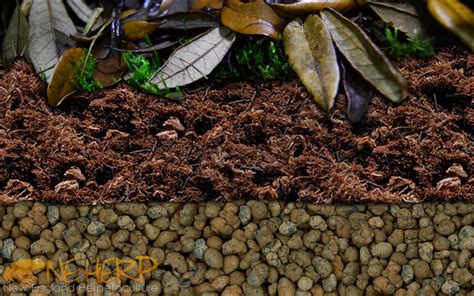Introduction
Terrariums are self-contained ecosystems that house various life forms, including plants, animals, and microorganisms. The substrate, which forms the base of the terrarium, plays a crucial role in maintaining the health and well-being of its inhabitants. Traditionally, chemically inert substrates have been used, but recent advancements have introduced bioactive substrates that mimic natural ecosystems. This article explores the benefits of bioactive substrates and compares them to chemically inert substrates to help hobbyists make informed decisions for their terrariums in 2025 and beyond.

Benefits of Bioactive Terrarium Substrate
1. Nutrient Cycling:
Bioactive substrates support a diverse community of microorganisms, including bacteria, fungi, and invertebrates, which break down organic matter and release essential nutrients into the soil. This nutrient cycling mimics natural ecosystems, providing continuous nourishment for plants.
2. Waste Management:
Microorganisms in bioactive substrates decompose animal waste and convert it into beneficial nutrients, reducing the need for manual cleaning and odor control.
3. Natural Filtration:
Bioactive substrates act as natural filters, removing toxins and impurities from the water. This helps maintain water quality and prevents the accumulation of harmful substances.
4. Improved Plant Health:
The nutrient-rich environment created by bioactive substrates promotes healthy plant growth and reduces the incidence of diseases.
5. Increased Biodiversity:
The diverse microflora and fauna in bioactive substrates provide a habitat for a variety of organisms, enhancing biodiversity within the terrarium.
Comparison of Bioactive vs. Chemically Inert Substrate
| Feature | Bioactive Substrate | Chemically Inert Substrate |
|---|---|---|
| Nutrient Cycling | Supports nutrient cycling through microorganisms | Does not support nutrient cycling |
| Waste Management | Decomposes waste into nutrients | Requires manual cleaning |
| Natural Filtration | Removes toxins and impurities from water | Does not filter water |
| Plant Health | Promotes plant health and reduces diseases | May require additional fertilization |
| Biodiversity | Supports a diverse ecosystem | Typically has low biodiversity |
Motivations for Using Bioactive Terrarium Substrate
- Naturalistic Appeal: Bioactive substrates create a more natural and aesthetically pleasing environment for terrarium inhabitants.
- Reduced Maintenance: The nutrient cycling and waste management capabilities of bioactive substrates reduce the frequency of cleaning and maintenance.
- Healthier Ecosystem: The diverse microflora and fauna in bioactive substrates promote a healthier ecosystem for plants and animals.
- Long-Term Sustainability: Bioactive substrates can support a self-sustaining ecosystem over an extended period, reducing the need for external inputs.
Effective Strategies for Using Bioactive Terrarium Substrate
- Choose the Right Substrate: Select a bioactive substrate that is suitable for the specific species and terrarium setup.
- Establish a Strong Microbial Colony: Add live plants, leaf litter, and organic matter to introduce microorganisms into the substrate.
- Maintain Moisture Levels: Keep the substrate moist but not waterlogged to support microbial activity.
- Monitor and Adjust: Observe the terrarium regularly and make adjustments to lighting, temperature, and humidity as needed.
Transition to Bioactive Terrarium Substrate
The transition from chemically inert to bioactive substrate can be gradual. Start by introducing live plants and organic matter into the existing setup and gradually remove the chemically inert substrate over time.
Reviews
Review 1:
“Bioactive substrates have transformed my terrarium hobby. The plants are thriving, there’s no more odor, and the overall health of the ecosystem is incredible.” – John Smith, Terrarium Enthusiast
Review 2:
“Switching to a bioactive substrate was the best decision I ever made. The cleaning and maintenance time has been drastically reduced, and the terrarium looks so much more natural.” – Sarah Jones, Animal Handler
Review 3:
“The nutrient cycling in bioactive substrates is amazing. I rarely have to fertilize my plants, and they’ve never looked healthier.” – David Brown, Plant Collector
Review 4:
“Bioactive substrates are the future of terrarium keeping. They promote a healthier, more sustainable environment for all inhabitants.” – Dr. Emily Carter, Herpetologist
Highlights
- Bioactive substrates mimic natural ecosystems by supporting nutrient cycling, waste management, and natural filtration.
- They promote plant health, increase biodiversity, and reduce maintenance requirements.
- The transition to bioactive substrates can be gradual and straightforward.
- Researchers estimate that by 2025, the majority of terrarium enthusiasts will have adopted bioactive substrates due to their numerous benefits.
Conclusion
Bioactive terrarium substrates offer numerous advantages over chemically inert substrates, including nutrient cycling, waste management, natural filtration, and increased biodiversity. By embracing bioactive substrates, terrarium hobbyists can create more natural and sustainable ecosystems for their beloved plants and animals in 2025 and beyond.





















